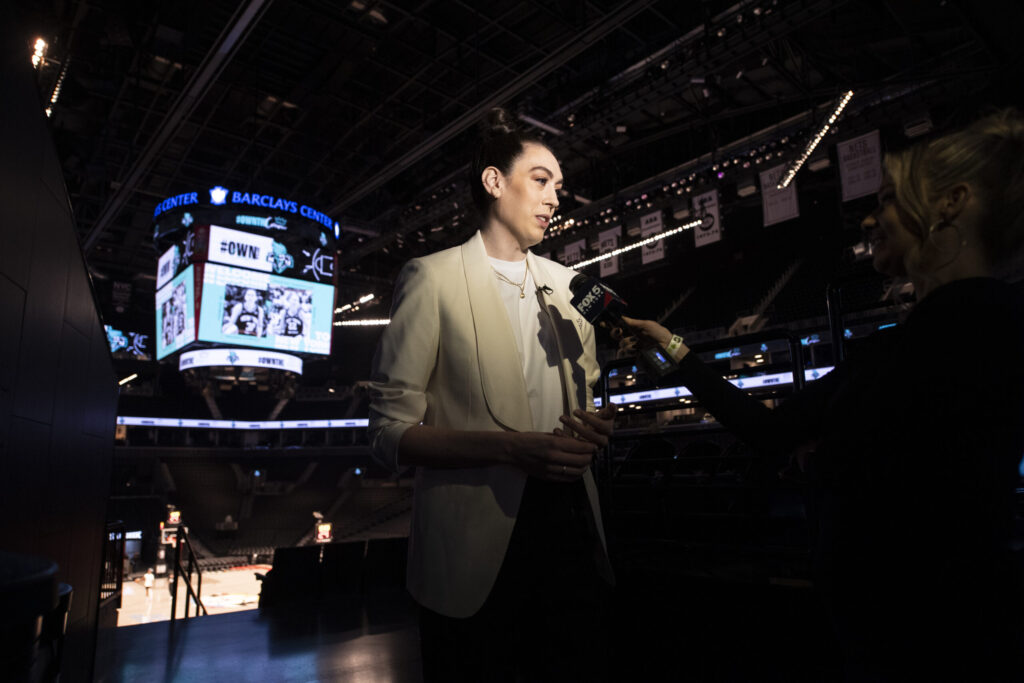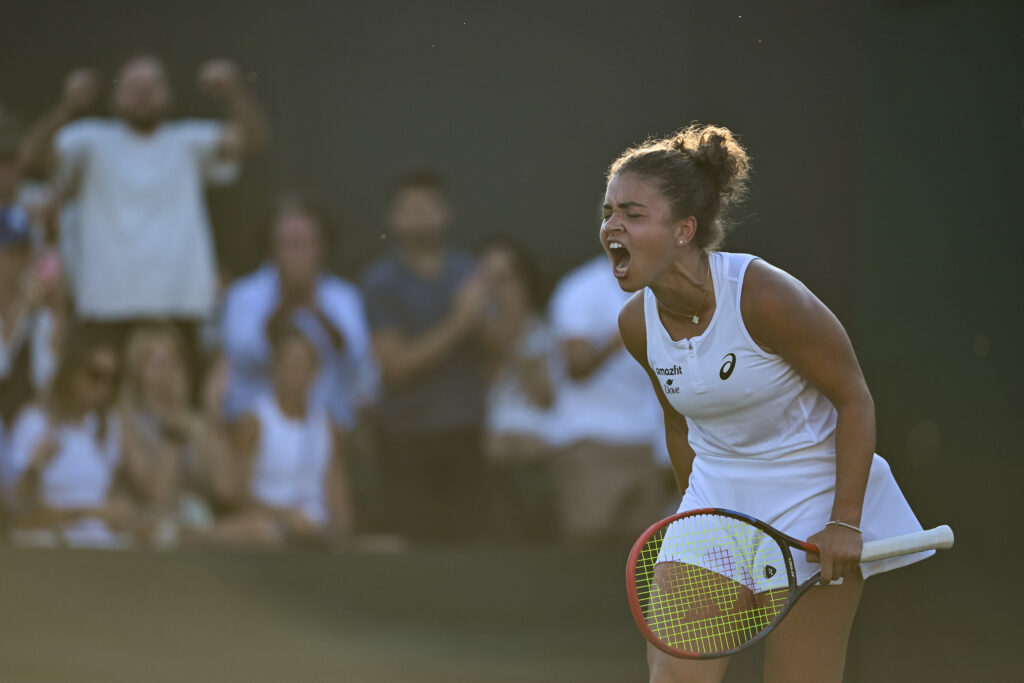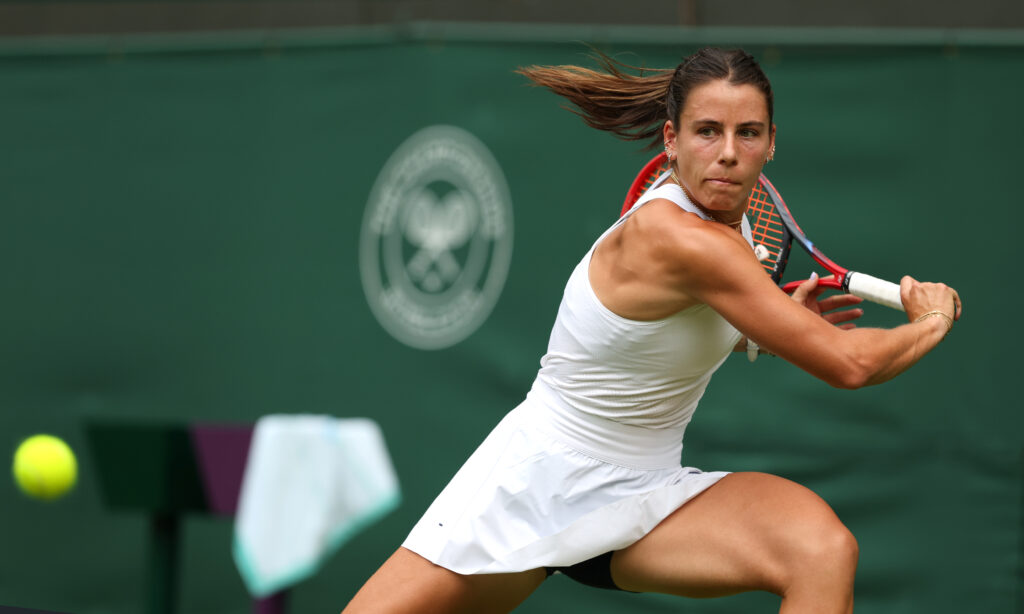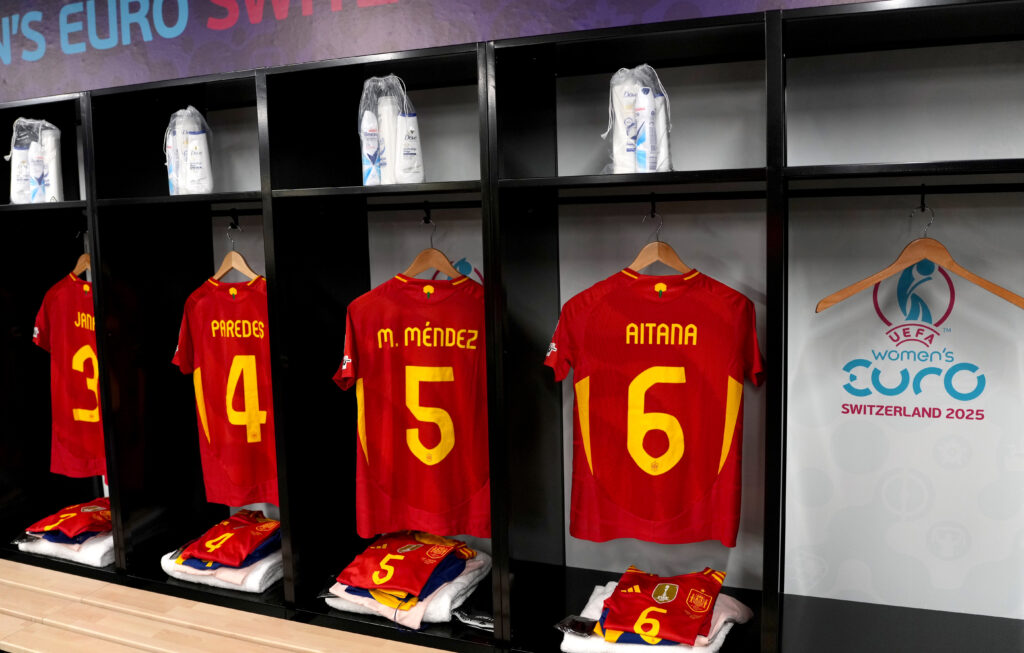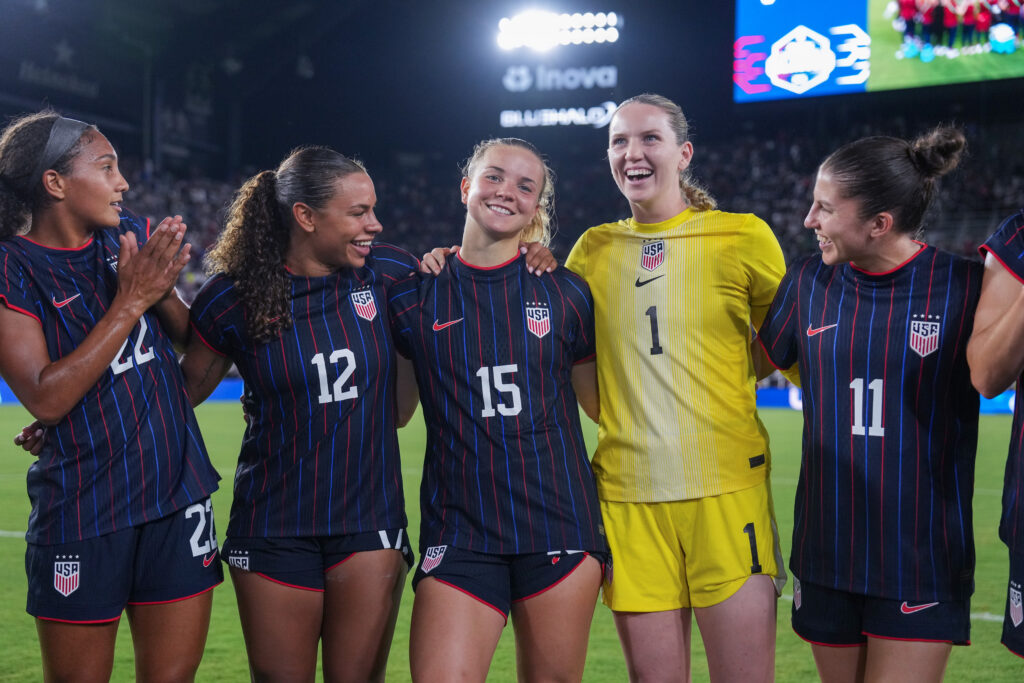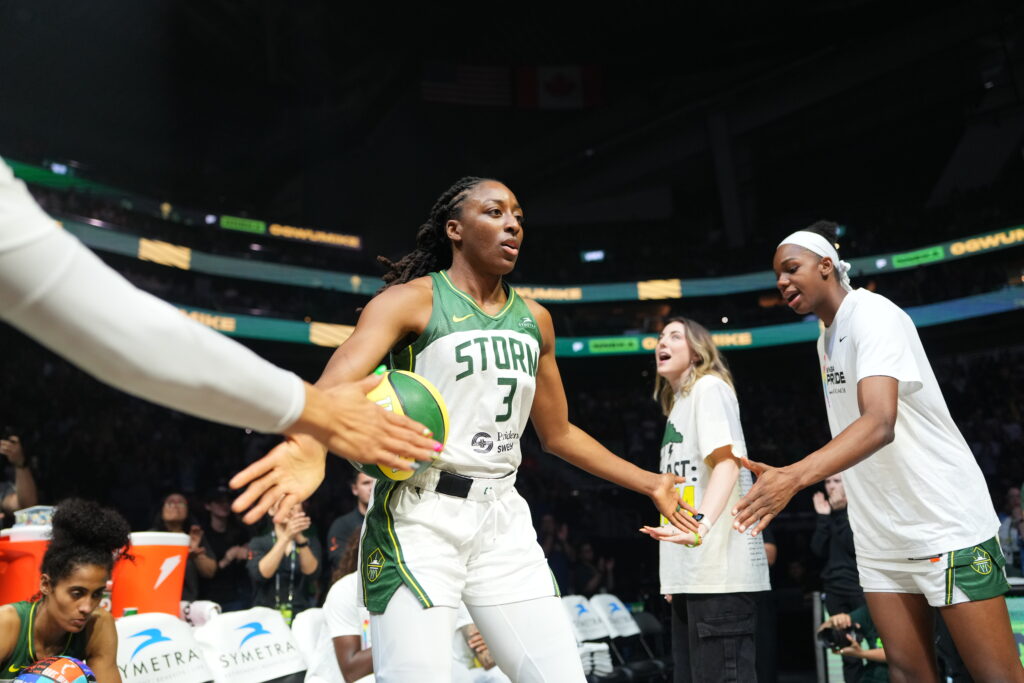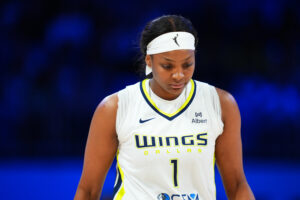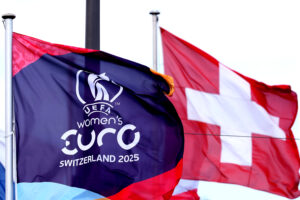Editors Note: This story was co-reported and co-written by Lyndsey D’Arcangelo and Rachel Galligan.
When WNBA free agency kicked off in February, the market was loaded with high-profile players looking for the right fit at just the right price. Since the league’s most recent CBA was ratified in 2020, higher salaries and player autonomy have made free agency a highly anticipated offseason event.
This year was no exception. In fact, it set a unique precedent.
With Candace Parker and Alysha Clark joining the reigning champion Las Vegas Aces, and Jonquel Jones, Courtney Vandersloot and Brenna Stewart signing with the New York Liberty, the WNBA entered what is being dubbed the “superteam era.”
What does this landscape shift mean for the league? We talked to a handful of general managers, coaches, players and former players to get their insight, both anonymously and on record. And they had plenty to say — not only about the future of the WNBA, but also about how the past ultimately led the league to where it is today.
The superteam era
What exactly is the superteam era? That’s up for interpretation, but one thing everyone can agree on is the attention that player movement and star-studded rosters have brought to the WNBA.
As Stewart lit up Twitter in January with ambiguous, emoji-filled tweets about which team she was going to choose, Vandersloot kept fans on edge as she swung back and forth between Seattle and New York before signing with the Liberty, and Parker shocked the world by joining Las Vegas instead of retiring or returning to Los Angeles for what could be her final season.
“Anytime you are bringing eyeballs and attention to the league, it’s a good thing. I certainly don’t think this is unique to the WNBA — we’ve seen it in a number of sports leagues in our country,” said Connecticut Sun head coach Stephanie White.
“I think it’s just that we are catching up, to be honest. The way things are from a salary structure, it’s a great thing that players are in positions now in their careers where they can take less to compete at a high level, and to compete with people and organizations that they want to.”
Despite the perceived novelty surrounding New York’s and Las Vegas’ stacked rosters, superteams are not new. The Houston Comets won four championships in a row from 1997 to 2000 with Cynthia Cooper, Tina Thompson and Sheryl Swoopes, forming the first superteam and established dynasty in the WNBA. The now-defunct Comets built their roster through the inaugural draft and the expansion draft the following season.

This superteam era looks different because it is a direct result of free agency, instead of teams muddling through losing seasons to stock up on top draft picks.
“If you think about Phoenix (Mercury) with Diana (Taurasi) and Brittney (Griner), well, how was that built? Well, they drafted BG the year after Diana sat out for the year. And so they didn’t win a lot of games and they got into the lottery,” said longtime WNBA analyst and former player Rebecca Lobo. “It’s the same thing in Minnesota. How did Minnesota build? They built through the draft by being bad and by getting Sylvia Fowles, who forced a trade to get there.
“There’s just a different taste in people’s mouths when they feel you bought your way there versus lost your way there. But in those examples, those were superteams.”
“I don’t know what everybody’s all wound up about,” said Indiana Fever general manager Lin Dunn. “The Comets were by far a superteam. The Detroit Shock were a superteam. The Minnesota Lynx were a superteam. … I’m excited that we now have two superteams.”
The current CBA stipulates that unrestricted free agents with five or more years of service, veterans who have been cut, and veterans who have completed the terms of their contract can negotiate freely with any team in the league and without another team claiming the right of first refusal. Additionally, franchise-caliber players can only be cored three times in their career, regardless of whether or not they do so with the same team.
With these rules turning free agency into a marquee event, teams with multiple stars and “Big Threes” are here to stay. While it’s easy to see superteams inhibiting parity, those in and around the league believe they’ll help raise both the level of interest in the league and the competition on the court.
“I mean, the buzz surrounding Parker going to Vegas, and Stewie and JJ and Courtney to New York was terrific and kind of broke through mainstream sports and interest and that sort of thing,” said Lobo. “The one thing that you know about the WNBA — games are still going to be competitive.”
“My hope is those two superteams are going to generate an enormous amount of interest in the WNBA,” said Dunn. “And while they’re worried about each other, some of us will sneak up and beat them unexpectedly. The most talented teams don’t always win.”
“It creates people talking about it. It makes other teams and other owners step up to remain competitive,” added a former player. “Just because you form a superteam doesn’t mean you’re going to win.”

Leveling the playing field
New York and Las Vegas were able to lure top-tier free agents to their respective franchises for a whole host of reasons. Location was a factor for some players; fanbase was another. But more than anything, owners with deep pockets were the biggest selling point.
Aces owner Mark Davis and Liberty owner Joe Tsai could not only negotiate competitive salaries, but also offer amenities that other franchises don’t have — like an innovative, newly-built practice facility for the Aces and the prospect of charter flights for the Liberty. In certain instances, those advantages have also gotten the two teams in trouble and led to complaints from their competitors.
In 2022, the WNBA fined the Liberty a record $500,000 for violating the CBA by chartering flights for their players in the second half of the 2021 season. On Tuesday, the league stripped the Aces of their 2025 first-round draft pick for violations related to promises of impermissible benefits when negotiating a contract extension with former player Dearica Hamby. Aces head coach Becky Hammon also was suspended for two games for comments she made in connection to Hamby’s recent pregnancy. Hamby accused the organization of mistreating her due to her pregnancy after she was traded to the Los Angeles Sparks in January.
League penalties notwithstanding, when certain owners have a decided financial advantage, it’s harder for smaller franchises without the same means to compete in the free agency market. Policies like the league’s salary cap and commercial flight rules were written into the CBA with the intention of maintaining a competitive balance.
“This league’s going to be great when you get owners with like, real, real money, you get the billionaires willing to spend. But at the same time, you don’t want to lose the owners who have been part of this for a long time and might not be billionaires but have invested all that they can invest,” said Lobo. “So, that’s the tricky part of it all. You have Tsai and Davis, who in the blink of an eye would say, ‘Yes, let’s charter,’ because they can afford a lot. Whereas other ownership groups, it might make them unable to continue to own the franchise. That’s a tough piece of it.”
Franchises with multiple owners haven’t put any less time and energy into their teams or the league as a whole. But they might end up in a position where they aren’t able to provide the same amenities as the league continues to evolve and player expectations rise.
Implementing a league-wide luxury tax, which would require teams to pay a penalty if their payroll exceeds the salary cap, is a possible solution. But getting everyone on board with that type of change would be a challenge in and of itself.
“If they did have a luxury tax then the players wouldn’t have to take less money,” said one former player. “If you have a luxury tax, then you can go over the cap and you can pay players what they deserve to be paid to be basketball players. We can’t even agree on every owner flying charter — I don’t think the luxury tax is something that will ever pass.”
“I know for a fact in our organization, we’re on board for charter flights. But we know there are rules in place and if every team can’t do it, we can’t do it, so we play within those rules,” said one assistant coach. “I think what gets lost in it is that only one team wants to charter. And it’s not true … I think the league can educate people on that.”

Dunn believes there’s already a level playing field in the league, as long as every team abides by the rules set forth in the 2020 CBA.
“We also have some other ways for players to make supplemental salaries that are legal, like the time-off bonus. They can stay in the city and they can do team marketing agreements. They can do league marketing agreements,” she said. “There are other ways other than their basic salary to make additional money that is legal by the CBA. So as long as we’re following those guidelines, I think it’s great.
“I think in some instances, when people do something a little out of the ordinary, they assume that people are cheating. And that may or may not be true.”
In early February, the WNBA announced it was investigating the Aces for discriminatory practices involving the treatment and subsequent trade of Hamby after she informed the team of her pregnancy. The league also looked into allegations of pay-for-play offers to current players and prospective free agents, as first reported by Howard Megdal of The Next.
As a result of the investigation, the WNBA announced the penalties this week, which the WNBA Players Association said “miss the mark” in a subsequent statement.
The irony here is that the WNBA implemented a similar practice of supplementing player salaries in order to lure players away from the ABL before the WNBA launched in 1997. Initially, players signed contracts with the WNBA instead of individual teams. And since the WNBA’s salaries could not compete with the ABL’s at the time, the league acted as a liaison, facilitating endorsement deals with car manufacturers or other companies to create additional income for star players.
“I’m sure there are loopholes that were not thought of that have been taken advantage of,” said White. “Look, every team, every player, every organization is trying to find the best advantage they can to win championships. I think that’s where we are right now and that’s where every pro sports team is. Some of the things we didn’t see as potentially happening are happening, so now we just have to re-evaluate. We have to figure out how we address this, how to adjust.”
In response to players’ calls for better travel conditions, the WNBA expanded its charter flight program this season to cover all postseason games and teams with back-to-back games during the regular season. The program will reportedly cost the WNBA an estimated $4.5 million. WNBA commissioner Cathy Engelbert has estimated that chartering flights for an entire season would cost the league around $25 million, and she has stressed the importance of building an economic model to fund it long-term.
“The league’s crisis management is not good,” added one analyst. “What Davis and Tsai want to do is just pay for charters, but you can’t do that if the rest of the league isn’t chartering. So how do you pay for charters? You have to build up the economic business model, you can’t just do it one and done — you have to have sustainability. You’ve got to say, ‘We’re going to be able to charter for the next five years, and this is what we’re going to get in return on our investment.’”
When the WNBA raised $75 million from more than two dozen investors last year, Engelbert said she hoped to “move faster on transforming the economics of h the league.” But some have been left wondering how that capital is being used.
“What did Cathy Englebert do with the $75 million in equity she said she got and acquired? Where did that go?” asked one analyst. “Is that even real money or is that just a forecasted expectation of someone making those kinds of gifts to the league?”
Until the WNBA is in a position to implement league-wide measures like charter flights, those close to the league expect players to look to sign with teams that have the most resources and the best chance to win.
“Like 27 years in, are we that advanced at this point that the superteam isn’t necessary? I’m not sure that we are. I think we might need it,” said the analyst. “I don’t like to call it the ‘superteam,’ but that’s what’s happening — players are taking less and going to franchises where they can win. That’s what the guys are doing.”

The good and bad of the CBA
While the 2020 CBA moved the needle for the players in many positive ways, over three years later, the effect those decisions have had on cap space and rosters have become much clearer.
The number of available WNBA roster spots — 144 total or 12 per team — is often referred to in discussions about roster limitations. But since the latest CBA, that number has realistically fallen under 140, with many teams limited to 11 players due to higher salaries for star players and corresponding salary-cap restrictions.
“This is a legally binding agreement that everyone agreed to and maybe didn’t read the fine print,” said one assistant coach. “It’s typical, you dangle a carrot, here’s more money, oh s–t — well, now we can only have 10 or 11 players. Over the long haul, it doesn’t really add up. What we’re running into is what we all knew would happen.”
The hard salary cap was a prevailing theme in our conversations, with many pointing to the trend of players willing to take less to be a part of the top franchises in the league.
“The hard cap right now probably doesn’t seem like it’s working in the way it was intended, ” said Lobo. “The consequence is that players are just taking less money, and I don’t think that’s what the intent was for the cap or teams.”
Layshia Clarendon, as a member of the WNBA Players Association’s leadership committee, was active in negotiations leading up to the 2020 CBA. The current Los Angeles Sparks guard lamented the fact that the hard salary cap agreed to in the CBA has led to veterans getting squeezed out of rosters. The 32-year-old Clarendon has experienced the unpredictability firsthand, getting waived by both the Liberty and the Lynx in the past few years.
“The league would not budge on either counting that contract as a rookie contract or letting it go over the cap, however you spend it right, and allowing more space for teams to keep veterans,” Clarendon said.
“That’s the biggest thing that’s screwing veterans right now and it’s because of the league’s hard cap. With pregnancies and with vet minimum contracts, a couple of small changes could really help our league. It’s only hurting players at the end of the day.”

White, entering her first year as head coach of the Sun after playing five years in the WNBA from 1999-2004, reflected on the early days of the league under the first CBA and how both resources and player expectations have evolved since then.
“All we really wanted was insurance all year around. Now, the options for these women when it comes to building families, sustaining this as a career, while incorporating everything that women have to incorporate, I think it’s awesome,” she said.
“We still want to see change and more roster spots and more opportunities and all of those things that come naturally with building and sustaining a league. But I think the overall ability to compromise on how we best take care of these women who sacrifice so much to play in this league, while we continue to try and grow it for them and continue to try and have more advantages for them while keeping a strong business model so this game can be sustained forever, I think the steps that have been taken have been really good.”
While the WNBA season generally begins in May, leagues overseas run through the winter and finish at any point between the end of February and early May. For nearly three decades, players have been accustomed to playing year-round to supplement their WNBA salaries, often causing them to miss parts of or all of WNBA training camp or even the beginning of the regular season.
The WNBA’s new prioritization policy could restrict that stream of income for many players. According to the rule in the CBA, beginning on May 1, 2024, three-year veterans must be present at the start of training camp or they will face a full season suspension. From now on, players will have to make tough choices between trying out for limited WNBA roster spots and securing a paycheck.
“Those players who don’t know if they’re going to be on a WNBA roster, and then they don’t go overseas because they’re trying to put all their eggs into the WNBA basket with prioritization but then get cut, where is their income coming from?” said one former player.
“That is one negative that I feel like the players should have never agreed to. It’s going to have an impact on the average player. The veterans are already established financially, but you have that four-year, five-year (player) that makes $80,0000 in the WNBA — where are they going to play overseas?”
What’s next?
As the WNBA prepares to tip off its 27th season, many of the league’s shortcomings are once again driving the conversation. Draft picks and former NCAA stars are getting cut from rosters at an increasingly alarming rate, the timeline for expansion remains unclear, and players’ calls for higher salaries and better conditions are growing louder. Meanwhile, Engelbert continues to preach patience with the goal of turning the league into a sustainable business.
“There’s never gonna be enough transparency for people, just in terms of information, and it can always get better,” said an assistant coach. “I just think the league is growing and sometimes we forget we’re not 100 years old — not even 30.”
It’s easy to compare the WNBA to the NBA or other professional sports leagues that have been around for much longer and pick out all the shortcomings. But looking at the league today compared to where it was in its first decade, the big-picture growth is evident.
“We’re starting to build on some of those big-time problems because we actually have player movement, have money to be thrown around in different ways, and have owners who are willing to push the boundaries of the league,” said Clarendon. “I think it’s a big marker of growth. So I’m excited about it from that perspective, from a bird’s-eye view perspective. I think it’s like we’re really at a shifting point for the league.”
Much of that shift has stemmed from free agency and players having more autonomy over their career choices. When the league’s top stars choose teams like New York and Las Vegas, other organizations are incentivized to invest further and remain competitive.
“When you start losing free agents because you feel like you’re not investing as much as you should,” said one former player, “then something has to change or else you’re going to continue to lose players in free agency, because they’re always going to prefer another team over yours.”
As roster-building gets more competitive, those in and around the league want to see the WNBA clearly communicate and enforce the rules. The WNBA’s investigation of the Aces for alleged under-the-table payments, for example, was the result of what one current head coach described as an inevitable issue in the current league climate.
“You’re trying to put together the best possible team that you can. When there is a lack of clarity in exactly what you can do — every organization is looking for ways to move the needle. It doesn’t mean it’s right, wrong or indifferent; it’s just the way that it is when there is not a lot of clarity,” the coach said.
There will be an opportunity to address all of these issues in future negotiations, with the current CBA set to expire in 2027.
“Every CBA is so important. We don’t know what we don’t know. We are continuing to learn about the business model, the evolution of the players and their mentalities and what they want out of this experience,” said one head coach.
“We all have to remind ourselves that there is a bigger picture and we have to figure out how to keep the competitive advantage. There’s not always that balance. We may not ever have it, but how do we get as close to it as possible is the challenge.”
Lyndsey D’Arcangelo is a contributing writer at Just Women’s Sports, covering the WNBA. She also contributes to The Athletic and is the co-author of Hail Mary: The Rise and Fall of the National Women’s Football League. Follow Lyndsey on Twitter @darcangel21.
Rachel Galligan is a basketball analyst at Just Women’s Sports. A former professional basketball player and collegiate coach, she also contributes to Winsidr. Follow Rachel on Twitter @RachGall.
